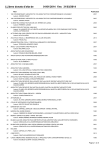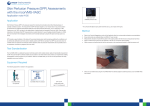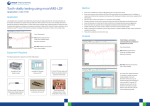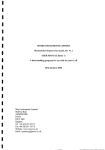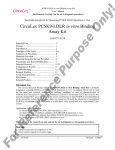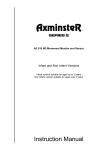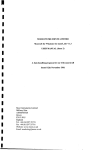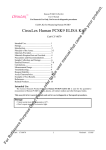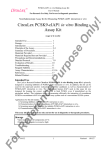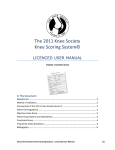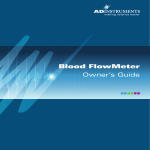Download Toe Blood Pressure (TBP) assessments using
Transcript
innovation in microvascular assessment Toe Blood Pressure (TBP) assessments using moorVMS-VASC Method Application note #108 • Refer to the Practical Suggestions Section of this Application Note for environmental and patient recommendations. • Ensure skin probes are calibrated (See moorVMS-LDF user manual). • Measurements should be made with the patient in the supine position – depending upon the size and position of the foot, the toe would be at (or just above) heart level (de Graff et al, 2000). Application • Place a pressure cuff around the proximal phalanx of the toe. • Place skin probes on the toe pulp (usually the great toe), distal to the cuff. • Set the moorVMS-VASC software – a preferred/standardized protocol can be set, see example below. Toe Blood Pressure (TBP) is the measurement of distal limb systolic blood pressure at the toe. TBP is particularly useful in patients with noncompressible tibial arteries, for example those suffering long-standing diabetes, renal failure or other disorders where vascular calcification is present (Clement, TASC II, 2008). TBP can be used in patients with peripheral artery disease (PAD) to assess the severity of ischaemia (Høyer et al, 2013, Høyer et al, 2014, Ubbink, 2004) and ultimately lead to early treatment and/or prevention of the formation of ischaemic ulcers in the lower limb. TBP measurements have been shown to be possible and reproducible using laser Doppler and automated pressure systems (Høyer et al, 2014, Wahlberg and Gush, 2002). In recent publications TBP was shown to have less inter and intraobserver variability than that reported for ABP (Påhlsson et al, 2008). In addition, a recent study showed good correlation between the moorVMS system and strain gauge plethesmography in a wide range of toe pressures in addition to substantial agreement for diagnostic classification of peripheral arterial disease(PAD) including critical limb ischaemia (CLI) (Høyer et al, 2013). Routine measurements of TBP can be performed simply and rapidly using the moorVMS-VASC system with a predefined, standardized test protocol. The user-friendly software enables user defined protocols to be set as required for research, however the user is not limited to pre-defined protocols. Equipment Required The following equipment is needed for this application: moorVMS-VASC moorVMS-VASC PC software Toe Cuff (Inflatable pressure cuff) ‘cart optional’ moorVMS-VASC protocol Setup for Toe Blood Pressure. VP1T combined optic and PAD double-sided temperature skin probe(s) adhesive discs 1 2 innovation in microvascular assessment Toe Blood Pressure (TBP) assessments using moorVMS-VASC Method Application note #108 • Refer to the Practical Suggestions Section of this Application Note for environmental and patient recommendations. • Ensure skin probes are calibrated (See moorVMS-LDF user manual). • Measurements should be made with the patient in the supine position – depending upon the size and position of the foot, the toe would be at (or just above) heart level (de Graff et al, 2000). Application • Place a pressure cuff around the proximal phalanx of the toe. • Place skin probes on the toe pulp (usually the great toe), distal to the cuff. • Set the moorVMS-VASC software – a preferred/standardized protocol can be set, see example below. Toe Blood Pressure (TBP) is the measurement of distal limb systolic blood pressure at the toe. TBP is particularly useful in patients with noncompressible tibial arteries, for example those suffering long-standing diabetes, renal failure or other disorders where vascular calcification is present (Clement, TASC II, 2008). TBP can be used in patients with peripheral artery disease (PAD) to assess the severity of ischaemia (Høyer et al, 2013, Høyer et al, 2014, Ubbink, 2004) and ultimately lead to early treatment and/or prevention of the formation of ischaemic ulcers in the lower limb. TBP measurements have been shown to be possible and reproducible using laser Doppler and automated pressure systems (Høyer et al, 2014, Wahlberg and Gush, 2002). In recent publications TBP was shown to have less inter and intraobserver variability than that reported for ABP (Påhlsson et al, 2008). In addition, a recent study showed good correlation between the moorVMS system and strain gauge plethesmography in a wide range of toe pressures in addition to substantial agreement for diagnostic classification of peripheral arterial disease(PAD) including critical limb ischaemia (CLI) (Høyer et al, 2013). Routine measurements of TBP can be performed simply and rapidly using the moorVMS-VASC system with a predefined, standardized test protocol. The user-friendly software enables user defined protocols to be set as required for research, however the user is not limited to pre-defined protocols. Equipment Required The following equipment is needed for this application: moorVMS-VASC moorVMS-VASC PC software Toe Cuff (Inflatable pressure cuff) ‘cart optional’ moorVMS-VASC protocol Setup for Toe Blood Pressure. VP1T combined optic and PAD double-sided temperature skin probe(s) adhesive discs 1 2 Analysis The TBP report contains the TP chart(s) in addition to the following information: Report format setting fully adjustable – enabling you to display as much, or as little data, as you require. Practical Suggestions TBP chart of results with easy options to edit, save and export data. Microvascular blood flow can be affected by many things. The following practical suggestions are provided as a guide and a. Sequence Statistics Table: are not exhaustive: • Measurement site • Deflation (mm Hg/s) • BP or TBP (mm Hg) • Flux channel • Flux (PU) • Pressure channel • Patients should avoid caffeine, alcohol, vigorous exercise, and smoking for 24 hours prior to the measurements. • Flux BZ (baseline) • Average • During all measurements ask the patient to breathe normally. Coughing, talking and yawning can all affect microvascular • Time (hh:m:ss) • Pressure calculation • patient is acclimatised to the room temperature for 30 minutes prior to the measurements. blood flow readings. b. Site mean Pressure Statistics table (following multiple assessments of limb blood pressure (LBP) or TBP • Site • Perform measurements in a quiet room whilst maintaining a comfortable temperature (typically 22°C – 24°C). Ensure the • The patient should be in a comfortable, relaxed position and avoid movement during all measurements. • Cover the feet/legs with a blanket to avoid cooling during acclimatisation and during measurements. Related Fields Mean LBP or TBP (mm Hg) c. The pressure detection point can be selected by the User in the Report Design section from the following options: Contact us for Application Notes for: Post Occlusion Reactive Hyperaemia (PORH), Skin Perfusion Pressure (SPP), Pulse • 1.2 x Biological zero (i.e. LD 1.2 x flux • 2.0 x Biological zero Volume (PV) and Ankle-Brachial Pressure Index (ABPI) measurements with the moorVMS-VASC. Publications measured during occlusion) • 1.5 x Biological zero (default setting) • 2.5 x Biological zero • Flux (PU) • 5.0 x Biological zero Clement D. 2008 Diagnosis and evaluation of peripheral artery disease – non invasive vascular laboratory and imaging techniques. Based on the Inter-Society Consensus. www.tasc-2-pad.org de Graff J. C., Ubbink D. T., Legemate D. A., de Haan R. J., Jacobs H. M. 2000 The usefulness of a laser Doppler in the measurement of toe blood pressures. Journal of Vascular Surgery 32 (6), pp1172-1178 Høyer C., Sandermann J., Paludan J.P.D., Pavar S., Petersen L. J. 2013 Diagnostic accuracy of laser Doppler flowmetry versus strain gauge plethysmography for segmental pressure measurement Journal of Vascular Surgery. 58 (6), pp 1563–1570 3 4 Analysis The TBP report contains the TP chart(s) in addition to the following information: Report format setting fully adjustable – enabling you to display as much, or as little data, as you require. Practical Suggestions TBP chart of results with easy options to edit, save and export data. Microvascular blood flow can be affected by many things. The following practical suggestions are provided as a guide and a. Sequence Statistics Table: are not exhaustive: • Measurement site • Deflation (mm Hg/s) • BP or TBP (mm Hg) • Flux channel • Flux (PU) • Pressure channel • Patients should avoid caffeine, alcohol, vigorous exercise, and smoking for 24 hours prior to the measurements. • Flux BZ (baseline) • Average • During all measurements ask the patient to breathe normally. Coughing, talking and yawning can all affect microvascular • Time (hh:m:ss) • Pressure calculation • patient is acclimatised to the room temperature for 30 minutes prior to the measurements. blood flow readings. b. Site mean Pressure Statistics table (following multiple assessments of limb blood pressure (LBP) or TBP • Site • Perform measurements in a quiet room whilst maintaining a comfortable temperature (typically 22°C – 24°C). Ensure the • The patient should be in a comfortable, relaxed position and avoid movement during all measurements. • Cover the feet/legs with a blanket to avoid cooling during acclimatisation and during measurements. Related Fields Mean LBP or TBP (mm Hg) c. The pressure detection point can be selected by the User in the Report Design section from the following options: Contact us for Application Notes for: Post Occlusion Reactive Hyperaemia (PORH), Skin Perfusion Pressure (SPP), Pulse • 1.2 x Biological zero (i.e. LD 1.2 x flux • 2.0 x Biological zero Volume (PV) and Ankle-Brachial Pressure Index (ABPI) measurements with the moorVMS-VASC. Publications measured during occlusion) • 1.5 x Biological zero (default setting) • 2.5 x Biological zero • Flux (PU) • 5.0 x Biological zero Clement D. 2008 Diagnosis and evaluation of peripheral artery disease – non invasive vascular laboratory and imaging techniques. Based on the Inter-Society Consensus. www.tasc-2-pad.org de Graff J. C., Ubbink D. T., Legemate D. A., de Haan R. J., Jacobs H. M. 2000 The usefulness of a laser Doppler in the measurement of toe blood pressures. Journal of Vascular Surgery 32 (6), pp1172-1178 Høyer C., Sandermann J., Paludan J.P.D., Pavar S., Petersen L. J. 2013 Diagnostic accuracy of laser Doppler flowmetry versus strain gauge plethysmography for segmental pressure measurement Journal of Vascular Surgery. 58 (6), pp 1563–1570 3 4 Høyer C., Paludan J.P.D., Pavar S., Biurrun Manresa J.A., Petersen L.J. 2014. Reliability of laser Doppler flowmetry curve reading for measurement of toe and ankle pressures: Intra- and Inter-observer variation. European Journal of Vascular and Endovascular Surgery, 47(3), pp311-318. Påhlsson H. I., Lund, K., Jörneskog G., Gush R., Wahlberg E. 2008 The validity and reliability of automated and manually measured toe blood pressure in ischemic legs of diabetic patients. European journal of Endovascular Surgery, 36, pp 576-581 Ubbink, D.Th. 2004 Toe blood pressure measurements in patients suspected of leg ischaemia: A new laser Doppler device compared with photoplethysmography. European Journal of Endovascular Surgery, 27, pp 629-634 Wahlberg E., Gush R. 2002 A new automated toe blood pressure monitor for assessment of limb ischemia. European Journal of Endovascular Surgery, 24, pp 304-308 Further Reading www.moor.co.uk – information about moorVMS-VASC and available probes and pressure cuffs. moorVMS-LDF user manual for instrument operation and cleaning and handling of optical probes. Please feel free to consult [email protected] for further advice or support with issues not covered in this application note and for details of other application notes using the moorVMS-VASC system. Important Disclaimer: This information is provided to further clinical research into diagnostic capabilities of laser Doppler. The moorVMS-VASC is CE marked for human use but not specifically for clinical diagnosis of TBP assessments. Calibrated equipment with a current service record should only be used. Notes innovation in microvascular assessment Moor Instruments Ltd Millwey Axminster Devon EX13 5HU UK tel +44 (0)1297 35715 fax +44 (0)1297 35716 email [email protected] website www.moor.co.uk Issue 3 5 6 Høyer C., Paludan J.P.D., Pavar S., Biurrun Manresa J.A., Petersen L.J. 2014. Reliability of laser Doppler flowmetry curve reading for measurement of toe and ankle pressures: Intra- and Inter-observer variation. European Journal of Vascular and Endovascular Surgery, 47(3), pp311-318. Påhlsson H. I., Lund, K., Jörneskog G., Gush R., Wahlberg E. 2008 The validity and reliability of automated and manually measured toe blood pressure in ischemic legs of diabetic patients. European journal of Endovascular Surgery, 36, pp 576-581 Ubbink, D.Th. 2004 Toe blood pressure measurements in patients suspected of leg ischaemia: A new laser Doppler device compared with photoplethysmography. European Journal of Endovascular Surgery, 27, pp 629-634 Wahlberg E., Gush R. 2002 A new automated toe blood pressure monitor for assessment of limb ischemia. European Journal of Endovascular Surgery, 24, pp 304-308 Further Reading www.moor.co.uk – information about moorVMS-VASC and available probes and pressure cuffs. moorVMS-VASC user manuals for instrument operation and cleaning and handling of optical probes. Please feel free to consult [email protected] for further advice or support with issues not covered in this application note and for details of other application notes using the moorVMS-VASC system. Important Disclaimer: This information is provided to further clinical research into diagnostic capabilities of laser Doppler. The moorVMS-VASC is CE marked for human use but not specifically for clinical diagnosis of TBP assessments. Calibrated equipment with a current service record should only be used. Notes innovation in microvascular assessment Moor Instruments Ltd Millwey Axminster Devon EX13 5HU UK tel +44 (0)1297 35715 fax +44 (0)1297 35716 email [email protected] website www.moor.co.uk Issue 3 5 6






